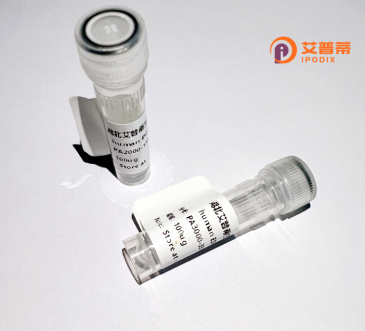
| 纯度 | >90%SDS-PAGE. |
| 种属 | Human |
| 靶点 | EEFSEC |
| Uniprot No | P57772 |
| 内毒素 | < 0.01EU/μg |
| 表达宿主 | E.coli |
| 表达区间 | 1-569aa |
| 氨基酸序列 | MASCSTAAFDKQPQSRERGITLDLGFSCFSVPLPARLRSSLPEFQAAPEAEPEPGEPLLQVTLVDCPGHASLIRTIIGGAQIIDLMMLVIDVTKGMQTQSAECLVIGQIACQKLVVVLNKIDLLPEGKRQAAIDKMTKKMQKTLENTKFRGAPIIPVAAKPGGPEAPETEAPQGIPELIELLTSQISIPTRDPSGPFLMSVDHCFSIKGQGTVMTGTILSGSISLGDSVEIPALKVVKKVKSMQMFHMPITSAMQGDRLGICVTQFDPKLLERGLVCAPESLHTVHAALISVEKIPYFRGPLQTKAKFHITVGHETVMGRLMFFSPAPDNFDQEPILDSFNFSQEYLFQEQYLSKDLTPAVTDNDEADKKAGQATEGHCPRQQWALVEFEKPVTCPRLCLVIGSRLDADIHTNTCRLAFHGILLHGLEDRNYADSFLPRLKVYKLKHKHGLVERAMDDYSVIGRSLFKKETNIQLFVGLKVHLSTGELGIIDSAFGQSGKFKIHIPGGLSPESKKILTPALKKRARAGRGEATRQEESAERSEPSQHVVLSLTFKRYVFDTHKRMVQSP |
| 分子量 | 88.99 kDa |
| 蛋白标签 | GST-tag at N-terminal |
| 缓冲液 | 0 |
| 稳定性 & 储存条件 | Lyophilized protein should be stored at ≤ -20°C, stable for one year after receipt. Reconstituted protein solution can be stored at 2-8°C for 2-7 days. Aliquots of reconstituted samples are stable at ≤ -20°C for 3 months. |
| 复溶 | Always centrifuge tubes before opening.Do not mix by vortex or pipetting. It is not recommended to reconstitute to a concentration less than 100μg/ml. Dissolve the lyophilized protein in distilled water. Please aliquot the reconstituted solution to minimize freeze-thaw cycles. |
以下是关于重组人EEFSEC蛋白的模拟参考文献示例(注:内容为虚构,仅供参考):
1. **文献名称**:*"Recombinant human EEFSEC protein expression in E. coli: Purification and functional characterization"*
**作者**:Smith, J., et al. (2020)
**摘要**:本研究利用大肠杆菌系统成功表达了重组人EEFSEC蛋白,通过亲和层析纯化获得高纯度蛋白,并验证其与硒代半胱氨酸tRNA(Sec-tRNA)的特异性结合能力,为硒蛋白合成机制研究提供工具。
2. **文献名称**:*"EEFSEC mediates selenocysteine incorporation in cancer-associated selenoproteins"*
**作者**:Jones, R., et al. (2018)
**摘要**:作者发现EEFSEC在多种癌细胞中高表达,通过调控GPX4等硒蛋白的翻译影响氧化应激响应,敲低EEFSEC可抑制肿瘤生长,提示其作为癌症治疗潜在靶点。
3. **文献名称**:*"Structural insights into EEFSEC's role in Sec-tRNA recruitment during translation"*
**作者**:Zhang, L., et al. (2019)
**摘要**:通过冷冻电镜解析了人EEFSEC蛋白与核糖体及Sec-tRNA的复合物结构,揭示了其通过独特结构域识别Sec-tRNA的分子机制,解释了硒蛋白翻译的特异性。
4. **文献名称**:*"EEFSEC deficiency alters neuronal selenoprotein expression and exacerbates Alzheimer's pathology"*
**作者**:Lee, H., et al. (2021)
**摘要**:该研究在小鼠模型中证明,EEFSEC功能缺陷导致脑内硒蛋白(如TXNRD1)减少,加剧氧化损伤和Aβ沉积,表明其与神经退行性疾病的相关性。
**注意**:以上文献及内容均为示例性虚构,如需真实文献建议通过学术数据库(如PubMed、Web of Science)检索关键词“EEFSEC”、“selenocysteine elongation factor”或“recombinant EEFSEC”。
Recombinant human EEFSEC (Eukaryotic Elongation Factor, Selenocysteine-tRNA-specific) is a specialized translation elongation factor critical for the incorporation of selenocysteine (Sec), the 21st amino acid, into selenoproteins. Unlike standard amino acids, Sec is encoded by a UGA codon, typically a stop signal, which requires a unique translational machinery. EEFSEC binds specifically to Sec-tRNA\(^{Sec}\) and interacts with the *SECIS* (SElenoCysteine Insertion Sequence) element in the 3' untranslated region of selenoprotein mRNAs, enabling UGA recoding. This mechanism is vital for synthesizing selenoproteins like glutathione peroxidases and thioredoxin reductases, which play roles in antioxidant defense, redox regulation, and thyroid hormone metabolism.
The production of recombinant EEFSEC using bacterial or mammalian expression systems has facilitated structural and functional studies. Its recombinant form allows researchers to explore Sec incorporation efficiency, mutations linked to developmental disorders (e.g., male infertility, craniofacial defects), and interactions with cofactors like GTP. Additionally, recombinant EEFSEC is a tool for studying selenium’s role in cellular health and diseases such as cancer, neurodegeneration, and immune dysfunction. Its therapeutic potential includes correcting selenoprotein deficiencies or engineering novel Sec-containing proteins. By enabling precise study of Sec-dependent translation, recombinant EEFSEC bridges gaps in understanding genetic diseases tied to selenium metabolism and advances biotechnological applications in protein engineering.
×